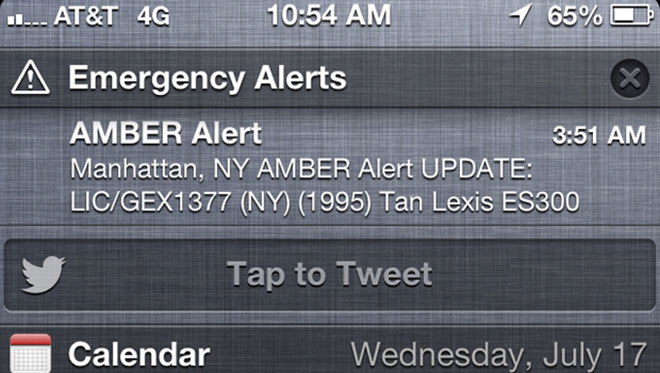
Wireless Emergency Alerts Give NYC a Rude Awakening
CTIA-The Wireless Association has worked with federal agencies to plug mobile phones into emergency warning systems like those for TV and radio. After a 4 a.m. Amber Alert woke many in New York City this week, some are questioning it.
If you live in New York City and own a smartphone, there’s a good chance you already know what this story’s about.
Very early Wednesday morning, the wireless emergency alert system, designed to draw attention to reports of severe weather and missing children, went off . It was an Amber Alert about a 7-month-old boy who had been abducted from a foster-care facility by his mother, who has a history of mental illness. (The boy was found unharmed later that day.)
You have a lot of people on the road at that hour. You’re looking for those eyes and ears to try to find that child.
The public is familiar with Amber Alerts, but this one was different. The system went off at 4 a.m. on thousands of phones throughout the city, leading some to raise concerns on social media that some other kind of emergency—a fire or weather emergency—had taken place.
The system caught many people off guard because it’s relatively new—the result of a public/private collaboration between CTIA-The Wireless Association, the Federal Emergency Management Agency, and the Federal Communications Commission.
More details on how the program works below:
About the system: In April 2012, the federal government, working in concert with CTIA, launched the Wireless Emergency Alerts program, a program mandated by Congress that will sound the alarm warning of a nearby emergency. In case of an alert, phones will make a loud noise—even those set only to vibrate. On December 31, the program expanded to the Amber Alert program, taking the place of a text-alert system that formerly performed the same function—although the former system was opt-in rather than opt-out. A spokeswoman for CTIA, speaking to The New York Times, noted that while service providers aren’t required to take part in the program, most do voluntarily, including all of the major ones.
Why at 4 a.m.? The National Center for Missing and Exploited Children, which was responsible for the notification according to the New York Post, told the Times that a report that the child was in a vehicle led to the decision to send out the alert at that hour—as time can be a major factor in such cases. “You have a lot of people on the road at that hour,” said Robert Hoever, director of special programs at the center, told the Times. “You’re looking for those eyes and ears to try to find that child.”
Can you turn it off? Yes, though the method varies by device. For iPhone owners, there are settings within the notifications panel that can be disabled. (You can turn off Amber Alerts and emergency alerts separately, in case you’d like to receive one, but not the other.) According to CBS News, you can also send a text message to disable the messages. Users of BlackBerry phones or Android devices may have to contact their carriers to disable it.
However, some types of alerts cannot be turned off—a rarely used presidential alert, set in motion only in a time of national crisis, is required to remain on by federal law, according to CTIA.
An image of the wireless alert sent out this week. (via CBS News)






Comments